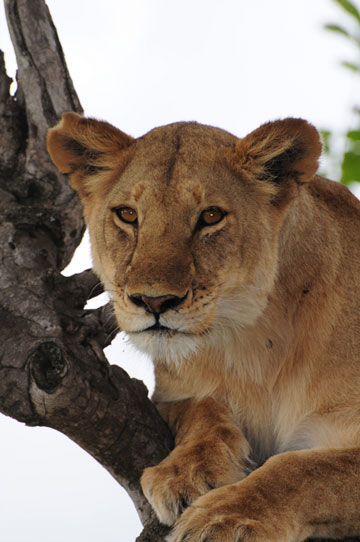 By NED ROZELL December 11, 2008
"Twenty-five percent of the world's mammals are endangered, and more than 50 percent show declining populations," Williams, a biology professor with the University of California, Santa Cruz, said on a recent visit to Fairbanks. She gave a lecture on the difficulties of being a mammal larger than about 50 pounds, one that is competing with humans and other animals for what it needs. "Once you get past that (weight), you have to bring in your calories through large prey," she said. "The bigger you are, the more space you're going to need." She showed images of three African lions, lounging with full bellies after a meal of some large animal on the hoof. She and her colleagues have estimated that lions rest for 80 percent of their day. During the other 20 percent of that 24-hour period, they need to bring in about 55 pounds of meat to maintain their metabolism. "A failed hunt on one day means a negative (energy) balance," she said. Williams is a physiologist who studies the amount of energy it takes for a creature to survive. During a career that has spanned three decades (which included heading the Valdez Sea Otter Rescue Center after the 1989 Exxon Valdez oil spill), she has counted the steps lions take when they are running, calculated the acceleration of Weddell seals zipping around under the winter sea ice surrounding Antarctica, and has captured the breath of elephants to determine their metabolic rate. She has noticed that large mammals are the creatures most at risk as human population increases and natural habitat shrinks. "You can either defend your limited resources or move on, and both options are incredibly energy-intensive," she said. Williams said she is a little dismayed that the number of carnivores listed as threatened or extinct has risen so dramatically since she became a biologist 30 years ago. While wondering how a physiologist could make a difference, she recently made a small discovery, while waiting out some downtime in Antarctica. Williams studied an online database of biology projects funded by a national agency. Contrary to the notion that charismatic megafauna like lions, tigers and bears are the most studied creatures around, she found that from 1999-2008, the national agency funded studies on single-celled organisms twenty times more often than it did projects on top carnivores. "We don't know enough about (large animals)," she said, and encouraged more study of the lives of big meat-eaters, such as the polar bear. "Maybe we can change the trajectory that large carnivores are on," she said.
Ned Rozell [nrozell@gi.alaska.edu] is a science writer at the institute.
Publish A Letter in SitNews Read Letters/Opinions
|
||
